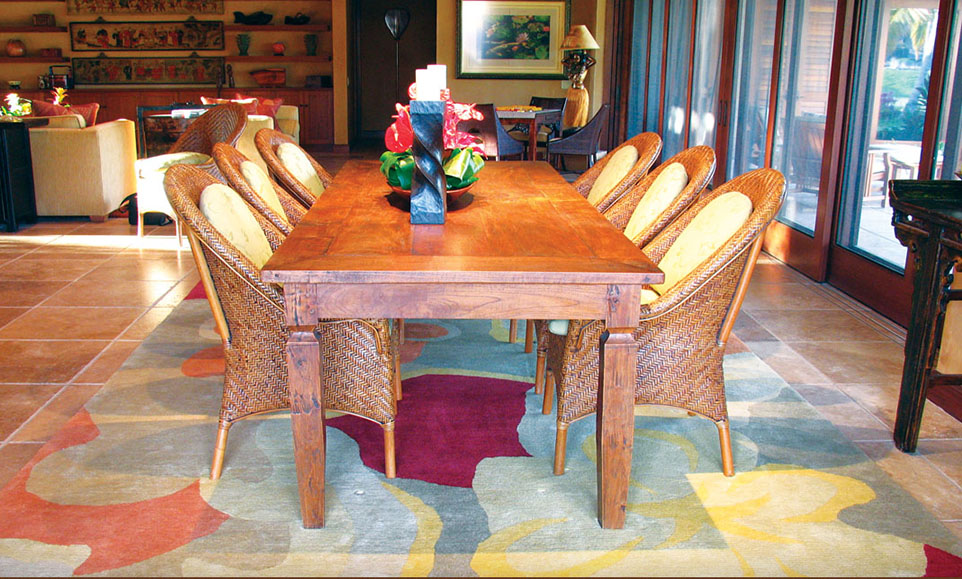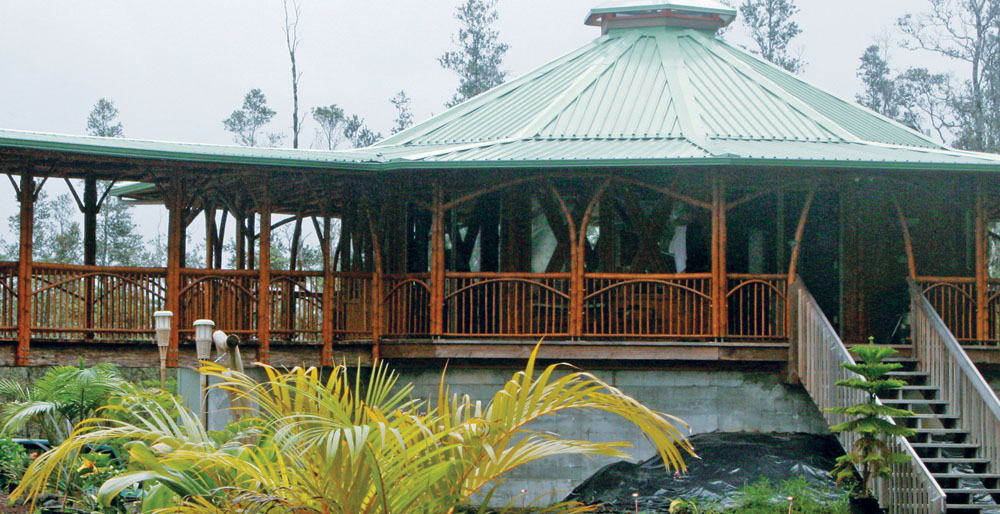
Art Under Foot: It’s More Than Just a Rug
By Karen Valentine
Walking barefoot inside your tropical Hawaiian home gives you an appreciation for the floor covering that’s more than esthetic. The tactile sense now becomes as important as the functionality, maintenance and appearance.
One option that may not be our initial thought is a pure-fiber rug of the Oriental type. You may think 100-percent wool, silk or hemp is impractical in the tropics, but the opposite is true.

Not only have the hand-woven rug techniques used in Nepal, India, China and Pakistan—producers of some of the finest hand-woven rugs in the world—been passed down for generations, the actual rugs survive for multiple generations. The wool, which is high in lanolin, is more stain resistant, easier to clean and lustrous than synthetic materials, while the hemp is also very durable as well as resistant to mildew, an asset for homes near the ocean.
Barbara DeFranco, manager of The Indich Collection in Kailua-Kona and design collaborator for many of the store’s rugs that are made especially for the Hawai‘i market, says they are like art under foot.
“I marvel at the craftsmanship and the subtleties created by the dye, the texture and the quality of the materials. Weaving is an ancient form of recording the cultural histories and landscapes, and not only have we brought the ancient industry into the Hawaiian Islands, but we’ve gone the next step, recording the beauty of Hawai‘i in the rugs.”
The Indich story is unique. Founder Bill Indich, a philosophy professor, merged his appreciation for the culture of Hawai‘i and the cultures of India and Tibet while traveling under a grant from the American Institute of Indian Studies back in the ‘70s. He and his wife, Susan, had also worked for a collector of Oriental rugs and art before they made a connection with a group of Tibetan rug exporters. They thought it would be a good idea to bring rugs to Hawaii.
They formed an importing business in 1979 out of their Oahu home, then expanded to a retail space in Honolulu and, years later, The Indich Collection has four locations, two in Honolulu, one in Maui and one in the Old Industrial Area in Kailua-Kona.

It was in 1996, after having sold tribal and traditional Persian, Indian and Chinese rugs in Hawai‘i for 17 years, that the Indiches decided to test-market something new—custom-made rugs featuring Hawaiian motifs. This was a natural attraction for Hawaii home decorators looking more for Hawaiian design than Persian (Iranian).
The rugs are still manufactured by hand, primarily in Nepal, India and China (due to long-term political problems in Iran), but they’re designed with tropical themes and colors that follow decorating trends.
“Hawaiians are a warm and generous people, and I wanted to convey the spirit of aloha in the rugs,” says Indich. Drawing on Hawaiian lore and tradition, he uses motifs such as the maile leaf woven with the ilima lei flowers to represent a strengthening of bonds between people, a binding together. Petroglyphs, banana leaf, monstera, lauhala, kapa, hibiscus and anthurium are also incorporated into the Hawaiian-themed designs.
As decorating trends change, the design team stays in touch with local and national interior design firms to anticipate what the market wants. Also, as the economy shifts, they are sensitive to the range of price people are able to pay.
“We stay on top of both the design and the economic trends,” says Indich. “As Kama‘aina ourselves, we are sensitive to people’s needs and are looking for long-term relationships with our customers.”
Today, for example, a more contemporary look has evolved, merging Hawaiian themes with Eastern, so a home can blend an Oriental theme with the tropical.
“The islands’ aesthetics are very much influenced by Chinese and Japanese sensitivities to art,” says Indich. Bamboo is one motif used to highlight the Asian simplicity and elegance of design. Colors, too, are becoming more subtle. In the last few years, he says, greens and golds have been replaced by chocolate and parfait colors such as turquoise, orange, and bright yellow. “Even pink and purple are coming back.” A special solid red, Volcano Red, honors the Big Island and Pele, says DeFranco.
The firm’s relationships with rug factories has survived over many years of political turmoil, as well as acceptance of different design requests, says Indich. Recently, more production has moved to India, due to problems in Nepal, for example. They stay with those makers they know are good and reliable, with an agent who inspects everything for quality control.
Sometimes a custom order can challenge the small-scale handmade rug operations, he says. The company was selected to furnish rugs for the suites at Hualalai Four Seasons Resort. This required a custom size and custom design for 220 huge rugs, said Indich. “It was earth-shattering news in Nepal. It required all the looms to make the 11-by -9, all-wool rugs. We’re proud to say we delivered the order in only four months.”
The collection includes rugs for all budgets, ranging from a $38 dhurrie to the $38,000 100-percent silk Persian Kashan fit for a palace. The Kona store offers customers the opportunity to try out a rug in their home before purchase. The company ships worldwide, and at no extra cost, to the Mainland. ❖


